Interesting and informative: we are witnessing milestones in the history of astronautics with the Orbiter
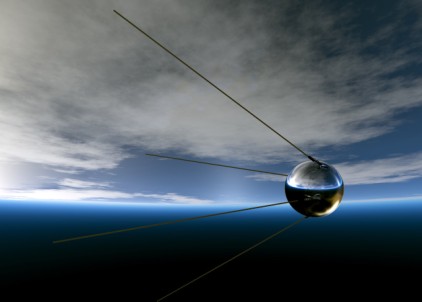
Animals and people can learn by playing. In fact, what could be better - both interesting and informative. Computer games are no exception, with some of them you can learn. I was very surprised when, searching for Habra, I found out that the Orbiter space simulator was only briefly mentioned here a couple of times. A free space simulator with an open architecture for add-ons and honest Newtonian physics turned out to be undeservedly overlooked. Probably because of its demands for the novice player.
Introduction
Honest Newtonian physics is a rare guest in games dedicated to flying in space. Such projects can be counted on the fingers: Orbiter , Kerbal Space Program, and little-known or forgotten Space Shuttle Mission 2007 and Microsoft Space Simulator 1994. The fact is that a serious attitude to orbital flights requires a preliminary study of the game guides and understanding of orbital mechanics (it is told in the manual, but who reads them?). Start the game after installation and immediately plunge into it, having fun, it will not work here. And the most interesting project is known only for a small share of stubborn fans. From here grows the idea of this article and the two goals that we will try to achieve:
')
- Fiction : causing an interest in this game, we increase the number of people who read the manual and who have enough interest to go through the training curve to the site where it will start to bring pleasure.
- Educational : thanks to the community of fans who have developed many add-ons for the game, we can become virtual witnesses of important space events. You can look at them yourself. You can show your children. Even in an educational institution you can show these flights in the classroom from physics to history.
To ensure the smallest threshold of entry, all the scenarios listed below do not imply your active participation - it is enough to put the game, add-ons, and watch the events unfolding.
Necessary start
First of all, remember about habraeffekt, some sites can fall off from the influx of users.
Download the latest version of the game ( 100830 ): official page , second source , another version , torrent on rutracker .
- Addon "Project R-7"
- Addon to "Project R-7" "Block E, Moon 1-3"
- Addon to "Project R-7" "Block L," Lightning "," Luna-9 ""
- Addon "Early missions R-7"
- Addon QC "Vostok"
- Addon "AMSO Apollo"
- (Optional) Additional textures of the Earth and the Moon (more is not needed yet): links , torrents .
- (Optional) Improved Baikonur textures: from here
Installation: first install the game itself. Then add-ons (just unpacking the game folder) in the following order: "Project R-7", "Block E", "Block L", "R-7: Early Missions", "East", "AMSO Apollo".
If some site fell under habraeffektomu, you can try to install this one here is a collection of add-ons over the installed game.
I also recommend opening the Video tab and setting up the “Window” mode with screen parameters equal to your monitor resolution. It will be more convenient.
Space age dawn
1957 Since July 1, the International Geophysical Year began. The United States announced its intention to launch an artificial satellite of the Earth. But then suddenly came on October 4, and Sputnik-1's “beep-beep-beep” sounded above the planet. Let's look at this epoch-making event. In reality, the launch took place at night, it can be seen badly, I recommend choosing a modified day scenario:
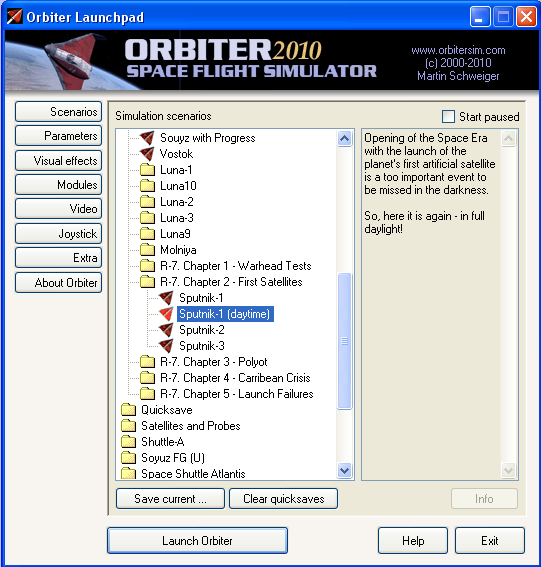
Click "Launch Orbiter" and see:
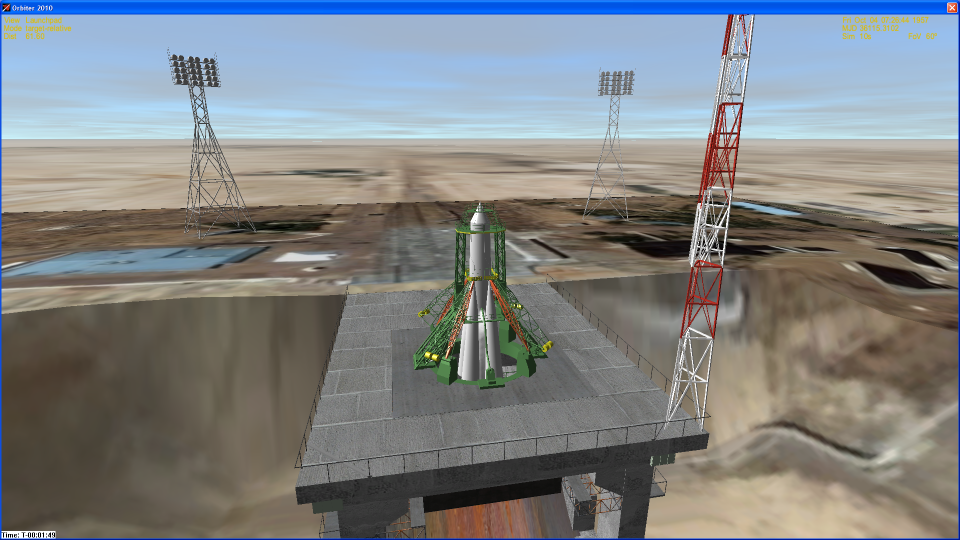
The startup process is fully automatic. No buttons need to be pressed. If there is not enough patience to wait for the prelaunch countdown, then the T button speeds up time by 10 times, the R button - slows down 10 times.
ATTENTION : in the scenario, possible failures are modeled, with a small probability the start can be emergency. Press Ctrl-Q to exit the game and restart the script.
Four painful minutes of launch, and a satellite in orbit!

A bit of history
Despite the simplicity of the design (two transmitters - 20 and 40 MHz, a thermometer and a barorel controlled the duration of the "beep" and the gap between the "beeps"), the first satellite had important scientific importance. He allowed to study the passage of radio waves through the entire atmosphere "from above", the density of the atmosphere and the parameters of aerodynamic deceleration, determine the parameters of heat regulation for future vehicles, observe and receive signals from a fast moving object. The political significance was immense. The Soviet Union convincingly demonstrated the high technology required for astronautics.
And what about the USA?
And in the United States began almost apocalyptic panic. “The Roman Empire,” said Johnson, “ruled the world because it knew how to build roads. Later, coming to the sea, the rules of the British Empire, because she had ships. In the aerial era, we were powerful because we had planes. And now the Communists staged a bridgehead in outer space! ” (Tom Wolfe,“ The Battle for Space ”). Of course, the United States made every effort to give the fastest possible response, collecting launch vehicles from those missiles that have already been developed. Their first attempt - the launch of the Vanguard satellite on December 6, 1957 ended with an epic file on the air . The American media went into the scrubbery, inventing offensive derivatives from the Soviet satellite: Flopnik, Oopsnik, Kaputnik. The second attempt was successful - a Redstone ballistic missile with three additional solid propellant steps put the first US satellite into orbit on January 31 . It would be very interesting to see this launch, but, alas, the script works only with the previous version of Orbiter - 060929 , and it is noticeably buggy with me. You can experiment , it is informative.
Second space
1958 Between the USA and the USSR there is a race for the second cosmic speed - the speed of leaving the Earth's orbit. Three "Moon" go "over the hill", the same sad fate befalls four "Pioneer." And so, on January 2, 1959, the launch of the device, which will be called "Luna-1" , took place. The scenario is interesting, but the start is again night, so for clarity, we choose the Luna-2 day start on September 12, 1959 :
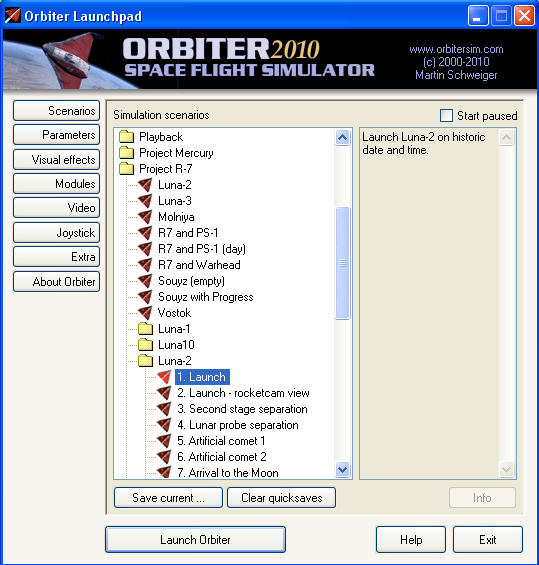
ATTENTION :
- After the launch of the rocket, you must manually switch the camera to "Luna-2". Press F3 , and select "Luna-2" in the window that appears.
- If you want to go to the moon, I do not advise you to speed up time at the launch site. The rocket honestly tries to aim at the desired trajectory, and the acceleration of time coarsens the calculations and control. The reverse is also true - for intentional flight past the moon, turn on x10 acceleration on the pullout.
- After separation from the third stage, switch the camera to the " global frame " mode (displayed on the left-top) by pressing F2 . Otherwise, the picture on the monitor will spin along with the unoriented station.
- The flight to the moon at the station took two days, do not hesitate to speed up time :)
A bit of history
In addition to the main task of hitting the moon, the “Luna” -1 and -2 carried a set of conventional sensors (Geiger counters, magnetometers, etc.) and two interesting experiments. The first was an artificial comet: a kilogram of sodium vapor was ejected from a tank in the third stage, which was observed from Earth as a weak asterisk. Unfortunately, in the latest version of this is not visible. You can try to look at 060929 . By the way, photos are available, as it looked in GAISH :
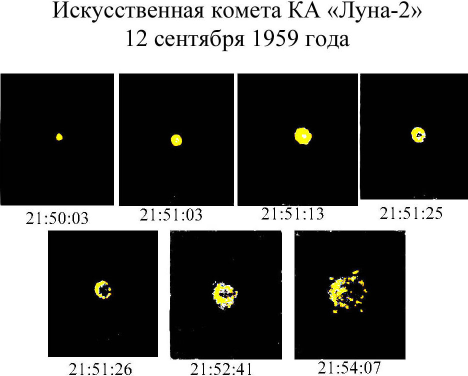
The second experiment was more engineering. The USSR wanted to deliver the pennant to the moon. But how to do it, if the speed of a collision with the lunar surface is 3.3 kilometers per second? Two types of pennants were made. The first was spherical, made up of pentagonal elements, with explosives inside. Upon impact, the explosive had to detonate and inhibit elements that were on top of the ball. An experiment was even conducted with two guns firing towards . The second type of pennant implemented Tsiolkovsky's ideas about anti-overloading baths - the ribbon with the pennant was in an ampoule with a liquid with aluminum density, an ampule in a heavy-duty alloy container, a container in a steel shirt, and a shirt in the third stage, which also crashed into the Moon. Upon impact, the container punched the shirt, braked, and the ampoule with the pennant remained intact. In the gaming scenario, even the first type is implemented - after hitting the moon, press F3 , and you will see a list of pennant elements flying along different trajectories.
And what about the USA?
There is a scenario with “Pioneer-4”, but it is completely old, and even in version 060929 it does not go into orbit. Very sorry. The Pioneer-4 itself weighed only 6 kilograms, and from the curious one can be noted, except that the rotation braking system: two weights on the ropes unwound (we recall some experience ) and slowed down the rotation of the vehicle. The idea was successful, such systems were used by the United States quite widely .
another side of the moon
From the receiving point reported:
“The range is fifty thousand.” The signal is steady. Have a welcome!
Gave a command to play the image. Again the responsibility lies with the FTU.
On paper line by line, a gray image appears. The circle on which the details can be discerned with sufficiently large imagination.
Korolev could not stand it and burst into our cramped room.
- Well, what have you got there?
“It turned out that the moon is round,” I said.
(B.E. Chertok, “Rockets and People”, book 2).
The question of what is on the far side of the moon has long troubled the minds of mankind. But without space technology, the answer is impossible. Therefore, photographing the far side of the moon was one of the closest goals in space exploration programs. And so, on October 4, 1959, Luna-3 started ( Project R-7 -> Luna-3 -> 1.Launch ):
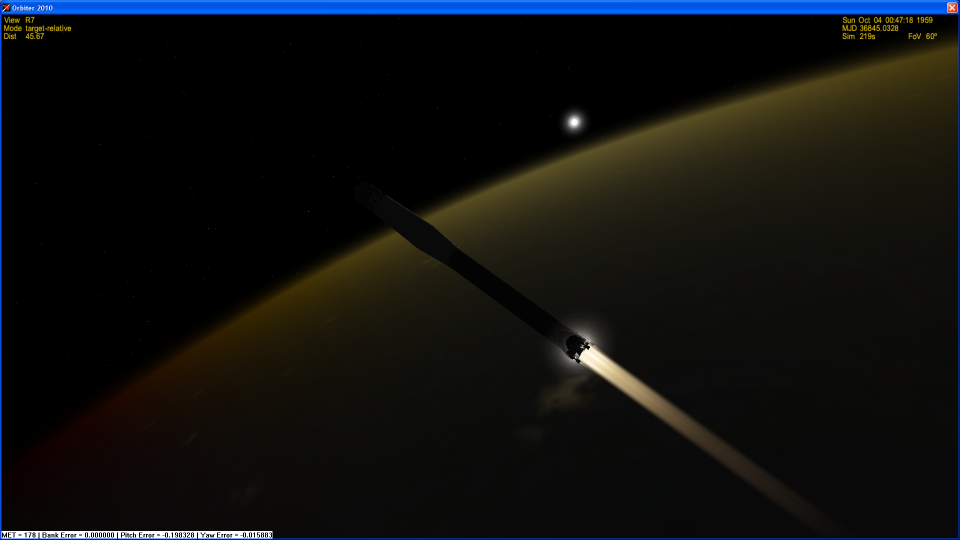
Run at dawn. The graphics at the present time unpretentious, but still pretty.

"Family portrait"

On the left - an imitation of a photo in the Orbiter, on the right - a real photo obtained from Luna-3.
ATTENTION :
- After the launch of the rocket, it is necessary to manually switch the camera to Luna-3. Press F3 and select “Luna-3” in the appeared window.
- Just in case, I do not recommend speeding up time on breeding.
- After the flyby of the moon, I do not recommend speeding up more than x1000 - you can “slip through” the photography area.
- Switching the appearance / view from the camera by pressing the F1 key .
- After switching to the transfer mode, I advise you to waste time on x10-x100 until you get a suitable signal level.
- The moon photo is located in the \ Photo \ Luna3 \ Received folder in the directory where you installed the Orbiter.
A bit of history
The mission of "Luna-3" at the time was extremely difficult. First, for the first time in history, a gravitational maneuver was used, so that after launching from the northern hemisphere, flying under the south pole of the moon, approach the Earth again from the northern hemisphere in appearance as the only long-distance center of the USSR in the Crimea. For clarity, the scheme is from here :
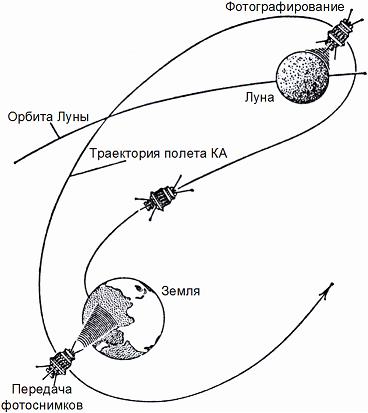
Secondly, the station had to orient in space in order to look at the moon and extinguish disturbances in order not to “blur” the photo. Thirdly, it was necessary to show the film on board. Fourth, transfer data to Earth. And fifth, to receive and decrypt data on Earth (this item was carried out as many as four different ways).
And what about the USA?
A series of probes "Pioneer" was supposed to photograph the reverse side of the moon as well. The Pioneer 4 was the most fortunate, but it also flew too far from the Moon, and the photosensor did not have enough light to activate. The first Americans to see the far side of the moon were the Apollo 8 astronauts in 1968.
Forever in history
We do not know the person who first caught on a tree that fell into the water and floated on it. We do not know who invented the scraps. Also, we do not know the person who invented the wheel. We can only guess where the inventor of the sail came from. But we absolutely know for sure who was the first in space - Gagarin, on April 12, 1961. (author unknown)
Before starting, be sure to activate "Vzor" - Modules -> put a tick in front of VZOR
Vostok (Rus) -> 2. Vostok - The First Manned Spacecraft -> Vostok (Gagarin)

Probably the most developed and beautiful collection of scenarios.
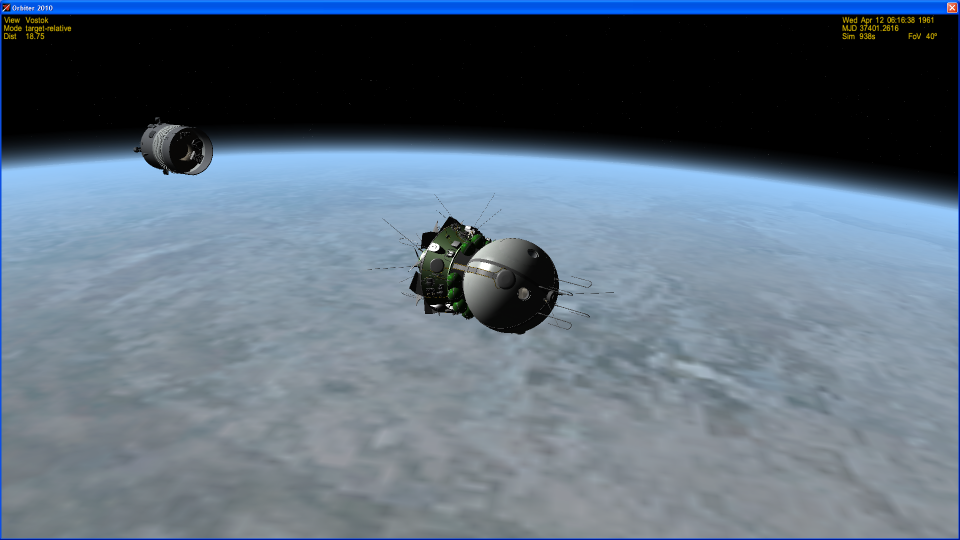
"Vostok-1" went into orbit! For F1 switch to the form "in the cockpit":
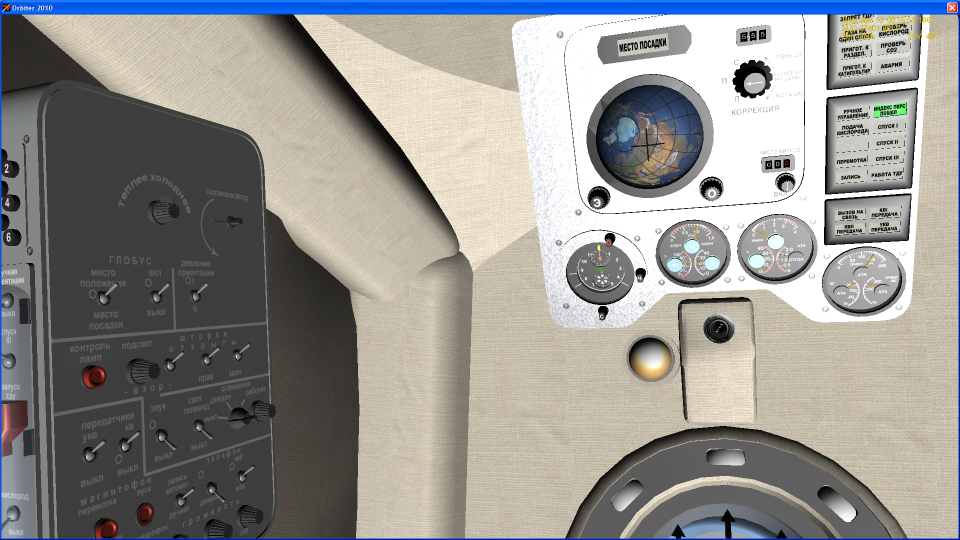
Buttons, switches - everything is pressed and working. There is a manual in Russian (in the \ Doc \ Vostok folder). The only thing that does not say there is the code that Gagarin had to dial (and you, if you want to experiment with the orientation of the ship) - 125 .
ATTENTION :
- After the braking impulse, the ship will start spinning fast enough - it was in reality. Switch to the global frame on the appearance or close the curtains of the porthole windows on the inside view.
A bit of history
This historical flight has repeatedly been in the balance of failure. When launching, the third stage dispersed the ship more than necessary, and in the event of a failure of the brake propulsion system (it is disposable and non-duplicated), the backup mode of descent by friction against the atmosphere would be impossible. After braking, the separation of the compartments was a backup method due to the shortage of the impulse of the braking system. After the ejection, the vent valve that did not open immediately caused a danger of suffocation. "Unauthorized" opened the reserve parachute. And finally, Gagarin almost fell in the Volga. But, thanks to the developers of the technology and the actions of the cosmonaut himself, the flight became a real triumph. It was truly a worldwide joy.
And what about the USA?
And in the United States was the program "Mercury" . There is a set of scripts for Orbiter: Earth addon 1962 (required) and Project Mercury itself . An interesting set of scenarios, also with an interactive cockpit, one problem - it only works in version 060929 . Very sorry. Visible is the difference in approaches to the design and piloting of spacecraft.
Hard way to a soft landing
February 3, 1966. The twelfth station of the Soviet program "E-6" for soft landing on the moon, dubbed "Luna-9" , is preparing for landing. The previous eleven stations did not fulfill their task: they did not descend from the reference orbit around the Earth, flew past the Moon or crashed on its surface. Probably, you are already tired of starting similar “sevens”, so we will switch right away at the time of landing: Project R-7 -> Luna-9 -> 07. Ready for landing sequence. :

ATTENTION:
- Do not turn on the acceleration of time - from the beginning of the script to the inclusion of the landing motor only two minutes!
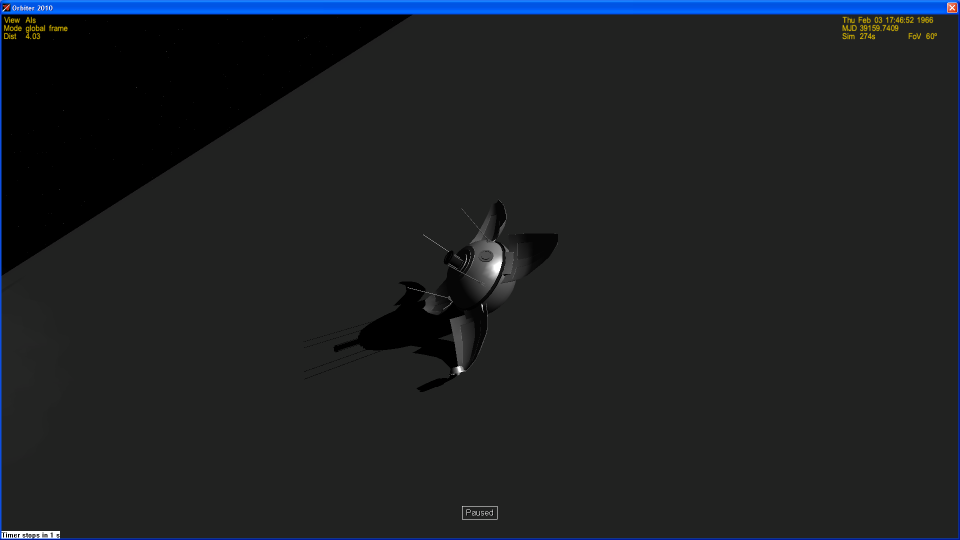
Have a soft landing! Go to the "inside" view of the F1 button and switch to pan mode with the F8 button. Press the button Start photo pan . Get a picture of the real panorama of the moon:
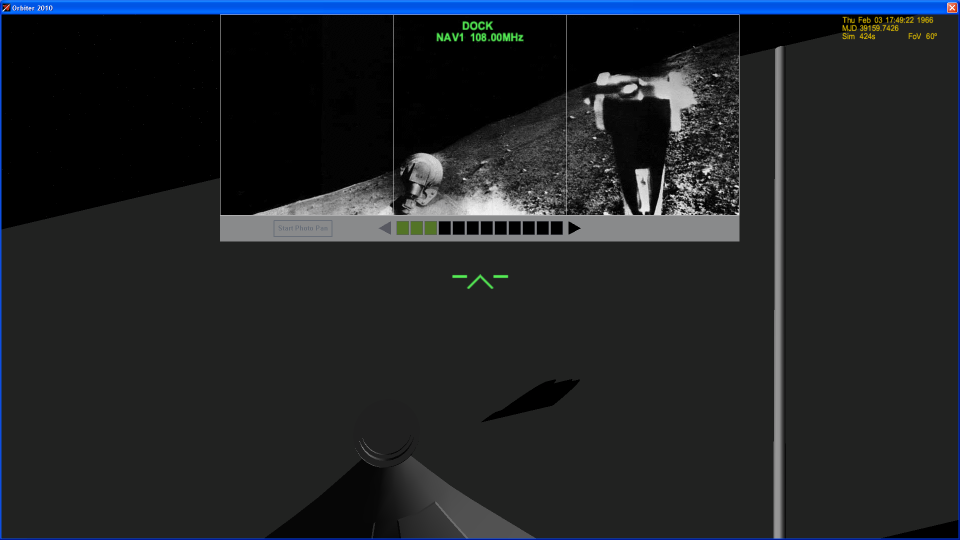
A bit of history
Luna 9 showed two very important things. First, she did not drown in the multimeter lunar dust, which with the light hand of Arthur Clarke engineers feared. Secondly, it measured the radioactivity of the lunar soil, the results of which were not very different from those on the earth. You can fly to the moon!
And what about the USA?
The United States had a very successful Surveyor program that performed the same task. First landing - June 2, 1966 . The Surveyor-1 scenario in Orbitter is there , it works in the latest version, but it has a fatal flaw - the lack of autopilot.
Top left
July 20, 1969. Lunar module "Eagle" Apollo 11 prepares for landing ( AMSO -> AS-506 -> Apollo-11 step 15 ):
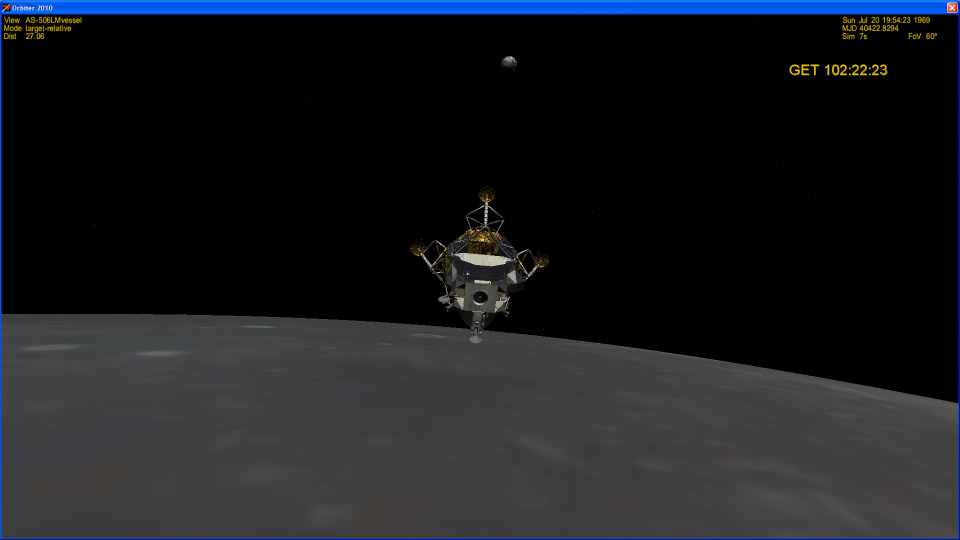
Press K , use the left and right buttons to scroll left-bottom text to the value of Engage PDI , press the "up" button. Automatic starts landing on the moon:

The F1 button switches the external / internal view. In internal view mode, the F8 button switches the 3D cockpit and virtual display.
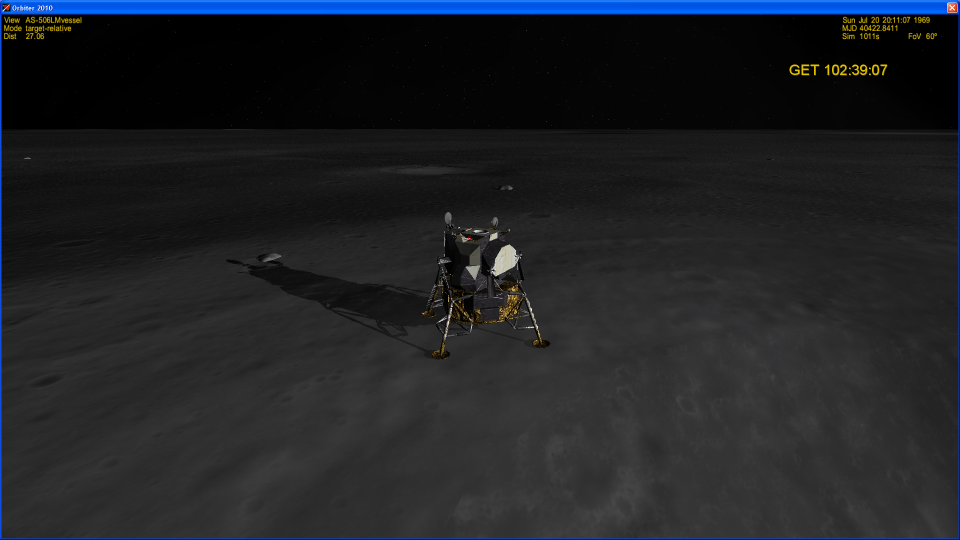
There is a landing!
A bit of history
Despite the "dress rehearsal" landing on the Apollo 10, landing on the moon was not an easy task. At the reduction site, the computer produced two atypical errors. The astronauts did not practice these errors, but, fortunately, engineers in Houston, looking at the documentation, found error codes and reported that they would not interfere with the landing. The computer of the lunar module, being a real-time system, signaled an overload. As it turned out, the mistakenly included docking radar added unnecessary information. The Apollo 11 was littered with the smallest supply of fuel from all subsequent ships, this was reinforced by the incorrect operation of the fuel level sensors. It is therefore not surprising that Houston responded to the report on the landing, “Understood you,“ Candy ... ”,“ Calm ”. You limp. We were all turned blue here. Now we breathe again. Thank you very much! ” After the eleventh“ Apollo ”there were five more landings on the moon, the last one took place in 1972. For forty years, the Moon has been waiting for man to step on its surface again. I hope we will live to see the return of humanity to this abandoned peak ...
And what about the USSR?
Soviet manned lunar program was . There is a script in Orbiter, but without autopilot and documentation. But the Americans were the first to succeed, and the Soviet Union did not risk it. Instead of people, automata flew to the moon - "Luna-16", "Luna-20" and "Luna-24" brought lunar soil, and "Luna-17" and "Luna-21" delivered rovers to the moon - lunar rovers -1 and - 2 Unfortunately, I did not find normal scenarios of this technique.
So what is next?
And further - to read the manual translated into Russian and other documentation . And realize what you want. Lesson plan or entertainment. Being a sandbox game, Orbiter gives you ample opportunities - to virtually fly on the Space Shuttle to the Hubble or on the Union to the ISS. Or turn on unlimited fuel, and, starting from Earth on the DeltaGlider, fly to the base on Mars. Benefit and pleasure are determined only by your diligence and imagination.
Source: https://habr.com/ru/post/186728/
All Articles